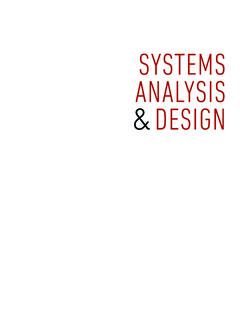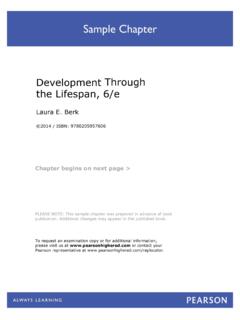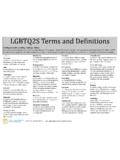Transcription of Literacy in the 21st Century - Pearson
1 Literacy in the 21st Centuryffective teachers create a nurturing classroom environment and provide high qual-ity and engaging Literacy instruction. They strive to make a real difference in thelives of their students. It s likely that you ll notice that teaching is different today than when you were a young adolescent. Our society has changed, and teachers facenew challenges today that reflect these DiversityMiddle-grade classrooms are culturally, linguistically, and academically diverse. Some stu-dents are learning to speak English at the same time they re learning to read and struggle with Literacy , and others exceed grade-level standards. Teachers create cul-turally responsive and inclusive classrooms where all students are respected and and Federal MandatesTeachers tailor their instructional programs to emphasize grade-level standards while dif-ferentiating instruction to meet individual students needs. They also juggle federal man-dates that are designed to assist underachievers and eliminate the achievement R T 8/10/09 3:40 PM Page 23rd proofHigh-Stakes TestsTeachers teach test-taking strategies and prepare students for annual standardized achieve-ment tests that measure students Literacy learning against grade-level standards.
2 Theseassessments are controversial because of the time test preparation and administration takesaway from teaching and because the results are used to make educational decisions aboutstudents and to evaluate teachers information and communication technologies, including Web browsers, word proces-sors, presentation software, blogs, video cams, and social networking sites, affect our un-derstanding of what it means to be literate and require that students learn new ways ofcommunicating through reading and writing. Teachers teach the strategies and skills thatstudents need to successfully use and adapt to rapidly expanding digital 1 Literacy in the 21st CenturyIn Part 1, you ll read these chapters:Chapter 1:Becoming an Effective Literacy TeacherChapter 2:Examining the Reading and Writing ProcessesChapter 3:Assessing Literacy LearningChapter 4:Differentiating InstructionThese chapters lay the foundation for teaching reading and writing to young adolescents andpreparing them to become productive citizens in the 21st Century .
3 You ll learn about how effec-tive Literacy teachers teach and assess students learning and how to accelerate students aca-demic S 8/10/09 3:40 PM Page 33rd proofBecoming an Effective Literacy Teacheriteracy is the ability to use both read-ing and writing for a variety of tasksat school and outside of school. Read-ing is a complex process of under-standing written text. Readers interpretmeaning in a way that s appropriate to thetype of text they re reading and to their pur-pose. Similarly, writing is a complex processof producing text; writers create meaning in a way that s appropriate to the genre and their purpose. Peter Afflerbach (2007b)describes reading as a dynamic, strategic, andgoal-oriented process. The same is true ofwriting. Dynamicmeans that readers and writ-ers are actively involved in reading and writ-ing. Strategicmeans that readers and writersconsciously monitor their learning. Goal-orientedmeans that reading and writing arepurposeful; readers and writers have a plan concept of what it means to be literate is changing.
4 Traditional definitionsof Literacy focused on the ability to readwords, but now Literacy is considered a tool,a means to participate more fully in the 21st Century s digital society. Kist (2005) talksabout new literacies sophisticated technological ways to read and write multimodaltexts incorporating words, images, and sounds which provide opportunities for students to create innovative spaces for making meaning, exploring the world, andvoicing their lives. These texts often combine varied forms of representation, includ-ing computer graphics, video clips, blogs, and digital photos, which students readand write differently than they do traditional books (Karchmer, Mallette, Kara-Soteriou, & Leu, 2005).CHAPTER 8/10/09 3:40 PM Page 43rd related texts are available online,and they influence each other. As students read, they pri-oritize, evaluate, and synthesize the often include interactive fea-tures to engage readers and allow them to customizetheir searches, link to other websites, and play and writing on the Internet require students tobecome proficient in new ways of accessing, comprehend-ing, and communicating information.
5 Students navigatethe Internet to search for information; coauthor onlinetexts as they impose an organization; evaluate the infor-mation s accuracy, relevance, and quality; and synthesizeinformation from multiple texts (Leu, Kinzer, Coiro, &Cammack, 2004).Writing online differs from using paper and pencil, s more informal, although most texts should be grammat-ically acceptable and use conventional spelling. Immediacy isanother difference: Writers post their writing within sec-onds. Third, writers create multimodal texts with digitalphotos, video clips, and website links. The fourth differenceis audience: Writers send e-mail messages to people in dis-tant locations, including military parents serving in Iraq andAfghanistan, and their postings are read by people in the 21st Century involves more than teachingstudents to read books and write using pen and paper; it sessential that teachers prepare students to use the Internetand other information-communication technologies success-fully (Karchmer, Mallette, Kara-Soteriou, & Leu, 2005).
6 The InternetThe Internet is rapidly changing what it meansto be literate. It s becoming common to seestudents involved in these online activities: Posting blogs on the class website Completing webquests Participating in virtual book clubs Researching informational topicsThese activities foster students engagement with readingand students learn to surf the Web, locate and readinformation, and communicate using e-mail, instant messag-ing, and blogs outside of school; others, however, haven thad many digital experiences. Teaching students how toread and write online has become a priority so that they be-come fully literate in today s flat texts are different than books (Castek, Bevans-Mangelson, & Goldstone, 2006). They re a unique genrewith these lacks the familiar linear organ-ization of books; instead, it s dynamic. Readers impose astructure to fit their needs and reconfigure the organiza-tion, if texts integrate words,images, and sound to create meaning.
7 Readers need toknow how to interpret each mode and how it contributesto the overall LiteraciesThis text focuses on teaching reading and writing in the middle grades. Studentsat this level fourth through eighth grades are called young adolescents; they re begin-ning the transition to adulthood that s marked by significant physical, social, and intel-lectual changes. The National Middle School Association s This We Believe(2003)document explains that students in the middle grades are forming the attitudes, val-ues, and habits of mind that will largely direct their behavior as adults (p. 1). Effectiveteachers use their knowledge about young adolescents to plan a relevant and challeng-ing curriculum, design instruction that engages students and addresses their needs, andensure students success through ongoing teach a diverse group of students in middle-grade classrooms. It s notunusual to have students reading at five or six grade levels, from second to seventhor eighth grade in a fifth-grade classroom, for example.
8 Today, too many studentsread significantly below grade level, and they can t access information in 8/10/09 3:40 PM Page 53rd proofPART 1 Literacy in the 21st Century6 textbooks or learn independently by reading. Many are English learners or from minority and low socioeconomic groups. These students are in real danger of never be-ing able to fully access information that will be crucial to their success in school and inthe workplace. It s essential that teachers close the achievement gap so that all studentscan reach their , Malloy, and Mazzoni (2007) recommend that teachers develop a visionof what they hope to achieve with the students they teach and then work to accomplishtheir plans. The goal of Literacy instruction is to ensure that all students achieve theirfull Literacy potential, and in that light, this chapter introduces eight principles of ef-fective Literacy instruction, and they provide the foundation for the chapters that 1: Effective Teachers Appreciate the Uniqueness of Young Adolescentsoung adolescents undergo a significant transition from childhood to ado-lescence.
9 You ve probably noticed kids aged 10 to 14 undergoing tremen-dous growth spurts, experiencing turbulent emotions, exhibiting distasteful publicbehavior, or demonstrating idealism through community projects. These behaviors aretypical. Some students begin the transition as early as fourth and fifth grades, and bysixth, seventh, and eighth grades, the progression is obvious. It s crucial that teachersunderstand these changes so that they can provide developmentally appropriate instruc-tion (Brown & Knowles, 2007).Characteristics of Young AdolescentsYoung adolescents experience dramatic physical, social, and intellectual changes dur-ing their transition to adolescence, and these changes directly affect their adolescents undergo tremendous biological changesas their bodies mature, including growth spurts and the onset of puberty:Growth and girls experience steady growth in height and weight be-fore puberty; then physical development accelerates.
10 This rapid growth increasesstudents nutrition and sleep , on average, reach puberty at age 11 and boys 2 years later. The onset of puberty causes observable changes in physical appearance, including breastgrowth in girls and voice change and facial hair in boys. These changes often makestudents self-conscious about their physical changes occurring during young adolescence are greater than in any otherstage except the one from birth to age adolescents strive toward independence during this broaden their social affiliations, search for identity, and address issues of socialjustice:Peer adolescents yearn to belong to a group, and peer approval be-comes as important as adult approval. They re extremely concerned about 8/10/09 3:40 PM Page 63rd proofin and overreact to ridicule and rejection. Same-sex friendships flourish; girls lookfor emotional support through their friendships, and boys seek friends who will lendsupport in times of trouble. Some kids join gangs to be part of a group and ensuretheir physical for begin the search to find out who they are and wherethey re going in life.











